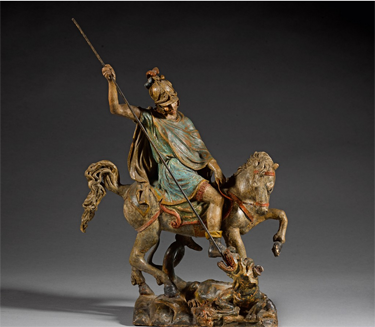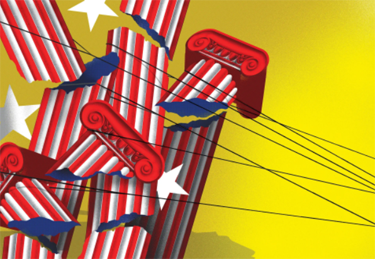Archive for April, 2022
23 Apr 2022


St. George, Italy, late 17th — early 18th Century.
Paul Kingsnorth, at the Abbey of Misrule, considers the appropriateness of St. George as England’s patron and has some good words for the dragon.
Back in the day, I was rooting for the dragon. It was a thing that some of us did back in the prehistoric nineties. Among the young, crusty eco-activists of yore, the myth of St George, patron saint of England, was another old story that needed to be turned on its head. As we battled to stop yet another square mile of English soil being concreted over for a motorway extension, superstore, housing estate, airport runway or whatever other embodiment of Progress was ‘necessary’ this week, we would hold up the dragon, not the saint, as our guiding light. This armoured human dealing out death to this innocent, wild creature: wasn’t it so appropriate that he would be the patron saint of this most modern and destructive of nations? The dragon, on the other hand was the icon of wildness, of untamed nature resisting the onslaught. Why couldn’t he be our saint instead?
As it happens, the dragon was once the symbol of England, back when St George was nowhere to be found. On Senlac Hill in 1066, Harold Godwinson, the last English king, was said to have fought William the Bastard’s Norman invaders under two banners: the dragon of Wessex, and the ‘fighting man’. The latter is still a mystery, and an intriguing one (I’ve often idly wondered if it looked anything like this.) But the dragon – or wyrm, to use the Old English – still flies on the official flag of Wessex today.
The king was defeated that day, of course – a story I wrote once – and the England which once flew the banner of the dragon now flies the banner of its slayer. But it always seemed to me, even when I was writing books about the state of England, that the English don’t care much for their patron saint. Perhaps we don’t care for any saints, and maybe that’s what haunts us. We wrecked most of their shrines during the Reformation, after all, and what did our national church replace them with? Ah yes: Helter Skelters.
RTWT
23 Apr 2022


Hans von Aachen, St. George Slaying the Dragon, c. 1600, Private Collection, London
From Robert Chambers, The Book of Days, 1869:
Butler, the historian of the Romish calendar, repudiates George of Cappadocia, and will have it that the famous saint was born of noble Christian parents, that he entered the army, and rose to a high grade in its ranks, until the persecution of his co-religionists by Diocletian compelled him to throw up his commission, and upbraid the emperor for his cruelty, by which bold conduct he lost his head and won his saintship. Whatever the real character of St. George might have been, he was held in great honour in England from a very early period. While in the calendars of the Greek and Latin churches he shared the twenty-third of April with other saints, a Saxon Martyrology declares the day dedicated to him alone; and after the Conquest his festival was celebrated after the approved fashion of Englishmen.
In 1344, this feast was made memorable by the creation of the noble Order of St. George, or the Blue Garter, the institution being inaugurated by a grand joust, in which forty of England’s best and bravest knights held the lists against the foreign chivalry attracted by the proclamation of the challenge through France, Burgundy, Hainault, Brabant, Flanders, and Germany. In the first year of the reign of Henry V, a council held at London decreed, at the instance of the king himself, that henceforth the feast of St. George should be observed by a double service; and for many years the festival was kept with great splendour at Windsor and other towns. Shakspeare, in Henry VI, makes the Regent Bedford say, on receiving the news of disasters in France:
Bonfires in France I am forthwith to make
To keep our great St. George’s feast withal!’
Edward VI promulgated certain statutes severing the connection between the ‘noble order’ and the saint; but on his death, Mary at once abrogated them as ‘impertinent, and tending to novelty.’ The festival continued to be observed until 1567, when, the ceremonies being thought incompatible with the reformed religion, Elizabeth ordered its discontinuance. James I, however, kept the 23rd of April to some extent, and the revival of the feast in all its glories was only prevented by the Civil War. So late as 1614, it was the custom for fashionable gentlemen to wear blue coats on St. George’s day, probably in imitation of the blue mantle worn by the Knights of the Garter.
In olden times, the standard of St. George was borne before our English kings in battle, and his name was the rallying cry of English warriors. According to Shakspeare, Henry V led the attack on Harfleur to the battle-cry of ‘God for Harry! England! and St. George!’ and ‘God and St. George’ was Talbot’s slogan on the fatal field of Patay. Edward of Wales exhorts his peace-loving parents to
‘Cheer these noble lords,
And hearten those that fight in your defence;
Unsheath your sword, good father, cry St. George!’
The fiery Richard invokes the same saint, and his rival can think of no better name to excite the ardour of his adherents:
‘Advance our standards, set upon our foes,
Our ancient word of courage, fair St. George,
Inspire us with the spleen of fiery dragons.’
England was not the only nation that fought under the banner of St. George, nor was the Order of the Garter the only chivalric institution in his honour. Sicily, Arragon, Valencia, Genoa, Malta, Barcelona, looked up to him as their guardian saint; and as to knightly orders bearing his name, a Venetian Order of St. George was created in 1200, a Spanish in 1317, an Austrian in 1470, a Genoese in 1472, and a Roman in 1492, to say nothing of the more modern ones of Bavaria (1729), Russia (1767), and Hanover (1839).
Legendarily the Sacred Military Constantinian Order of Saint George was founded by the Emperor Constantine (312-337 A.D.). On the factual level, the Constantinian Order is known to have functioned militarily in the Balkans in the 15th century against the Turk under the authority of descendants of the twelfth-century Byzantine Emperor Isaac II Angelus Comnenus.
We Lithuanians liked St. George as well. When I was a boy I attended St. George Lithuanian Parish Elementary School, and served mass at St. George Lithuanian Roman Catholic Church in Shenandoah, Pennsylvania.

St. George Church, Shenandoah, Pennsylvania, Christmas, 1979. This church, built by immigrant coal miners in 1891, was torn down by the Diocese of Allentown in 2010.
20 Apr 2022


Duke Law School
An article in the latest Duke Law Review by a Philosophy professor dissenting from the Progressive party line on Gender has provoked the inevitable conniption fit and a rash of resignations on the part of proper-thinking members of the Millennial generation.
Kathleen Stock’s essay in the latest issue of Law and Contemporary Problems was controversial before she even wrote it. Last summer eight student editors resigned from the journal, which is published by Duke University’s law school, rather than be associated with the essay. The remaining student editors elected not to work on the issue in protest, and they voiced their objections in a note appended to the journal’s masthead. The proposed topic, along with Stock’s reputation, was enough to prompt a staff revolt.
The essay, titled “The Importance of Referring to Human Sex in Language,” is part of the journal’s “Sex in Law” special issue, which is dedicated to the “high-stakes, highly polarized” debate surrounding how sex is defined by courts and legislatures. In it, Stock, who until last fall was a professor of philosophy at the University of Sussex, in England, argues against what she calls “sex-denialism.” The core of her case is the following: “Though it is normally polite and desirable to observe the preferred descriptors and pronouns of trans people in interpersonal contexts, there are times when literal and accurate reference to actual sex is important.” Among the times she cites: medical settings, sports teams, and prisons. Stock insists that “the concept woman does vital cognitive work that simply could not be done were the concept changed to refer to gender identity or social role.”
RTWT
HT: William Laffer.
20 Apr 2022

Oh me, oh my! Vanity Fair’s James Pogue visits the National Conservatism Conference and finds conspiring Peter Thiel, Curtis Yarvon, Amanda Milius (who must be the daughter of John Milius) and the rest of “the American right’s ‘radical young intellectuals,’ as a headline in The New Republic would soon put it, or conservatism’s ‘terrifying future,’ as David Brooks called them in The Atlantic.”
‘Why is it that whenever I see Curtis, he’s surrounded by a big table of incels?’ [Amanda Milius] asked with apparent fondness.”
17 Apr 2022


Peter Paul Rubens, The Resurrection of Christ, 1611-1612, Vrouwekathedraal, Antwerp
From Robert Chambers, The Book of Days, 1869:
Easter
Easter, the anniversary of our Lord’s resurrection from the dead, is one of the three great festivals of the Christian year,—the other two being Christmas and Whitsuntide. From the earliest period of Christianity down to the present day, it has always been celebrated by believers with the greatest joy, and accounted the Queen of Festivals. In primitive times it was usual for Christians to salute each other on the morning of this day by exclaiming, ‘Christ is risen;’ to which the person saluted replied, ‘Christ is risen indeed,’ or else, ‘ And hath appeared unto Simon;’—a custom still retained in the Greek Church. Easter retains many religious customs today but there are also many commercial aspects to the holiday. The Easter bunny, Easter candy and Easter baskets are all part of the celebration. Giving Easter baskets filled with candy is a joyous family activity, but it is important to remember the true meaning of the Easter holiday. Read the rest of this entry »
14 Apr 2022

Task and Purpose:
For recent proof of this centuries-old maxim, look no further than this photo of an abandoned Russian infantry fighting vehicle in Ukraine with the word “Wolverines” scrawled on the side in white spray paint in an apparent homage to the 1984 Cold War-era action flick “Red Dawn.”…
The photo was shared to Twitter on Thursday in response to a tweet by NPR’s White House correspondent, Scott Detrow, who wrote that “We were driving too fast to get a clear picture – but we just drove past a destroyed Russian tank with WOLVERINES spraypainted across it.” Fortunately, Oleg Tolmachev, the head of production for Ukrainian oil and gas company Naftogaz, had seen the exact same thing and snapped a photo of it.
RTWT
HT: Karen L. Myers.
14 Apr 2022

From Facebook:
You kill a policeman it means no arrest…no Miranda rights…no negotiations…nothing but as many bullets as we can shoot into you…period.” said Polk County Florida Sheriff, Grady Judd
An illegal immigrant, in Polk County, Florida, who got pulled over in a routine traffic stop and ended up “executing” the deputy, who stopped him.
The deputy was shot eight times, including once behind his right ear at close range. Another deputy was wounded and a police dog killed. The murderer was later found hiding in a wooded area.
As soon as he took a shot at the SWAT team, officers opened fire.
They hit the guy 68 times. Naturally, the liberal media went nuts and asked why they had to shoot the poor, undocumented immigrant 68 times.
Sheriff Grady Judd told the Orlando Sentinel: “Because that’s all the ammunition we had.”
Now, is that just about the all-time greatest answer or what!
The Coroner also reported that the man died of natural causes. 😂
When asked by a reporter how that could be, since there were 68 bullet wounds in his body, he simply replied: (BEST QUOTE ever) .. ..
“When you are shot 68 times, you are naturally gonna die.”
“Welcome to Florida, Y’all.”
Evidently a basically true story from 2006, though the news stories I found do not mention the bad guy being an illegal immigrant.
/div>

Feeds
|










